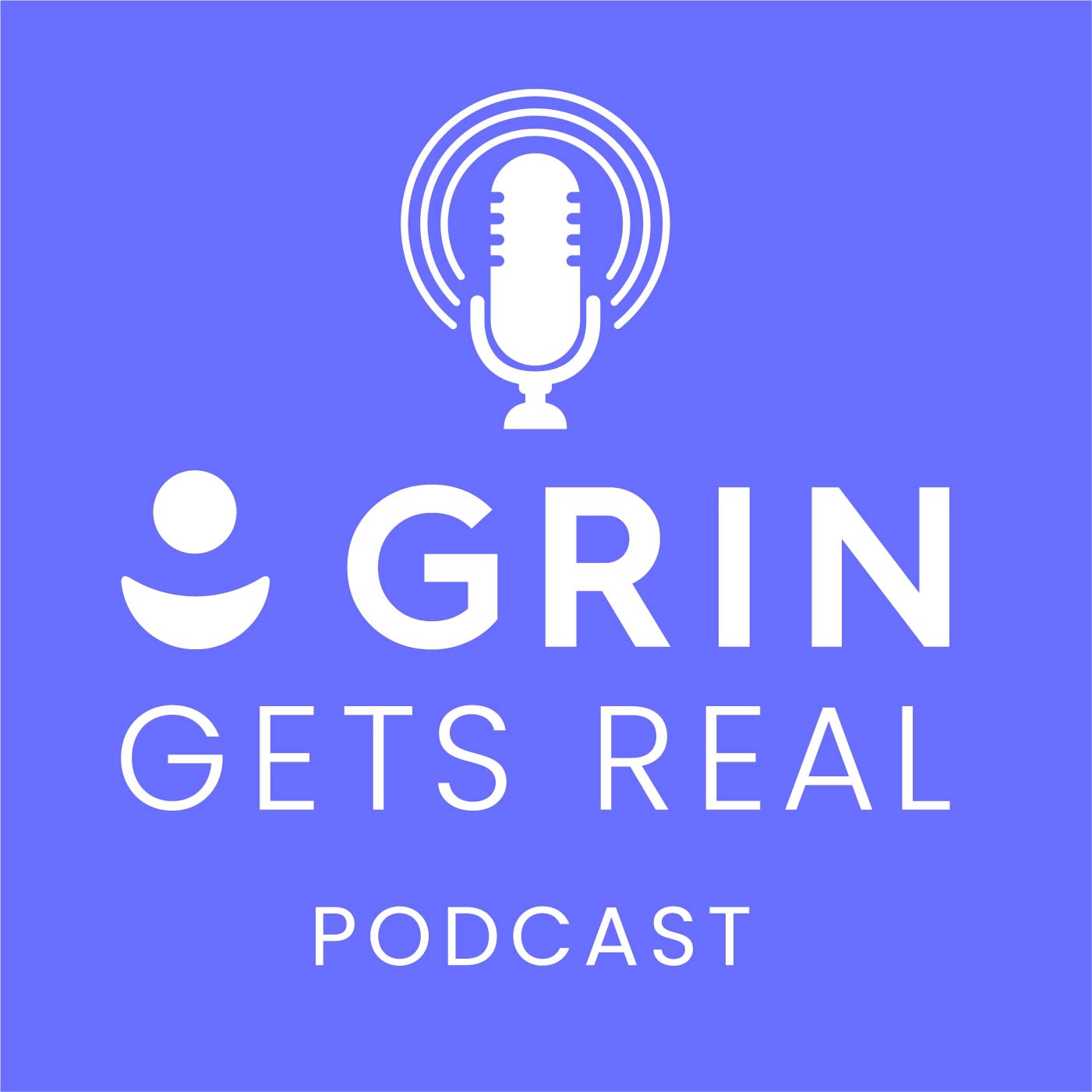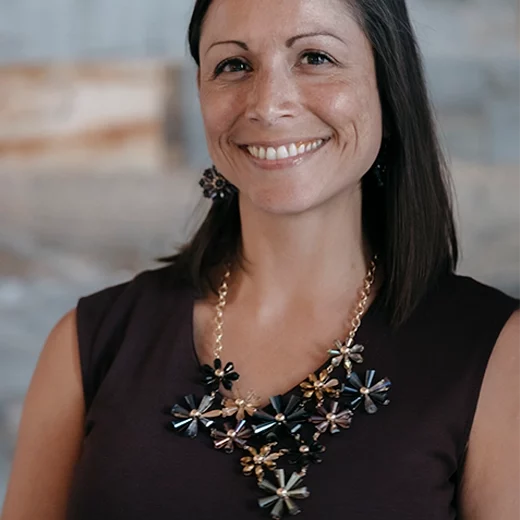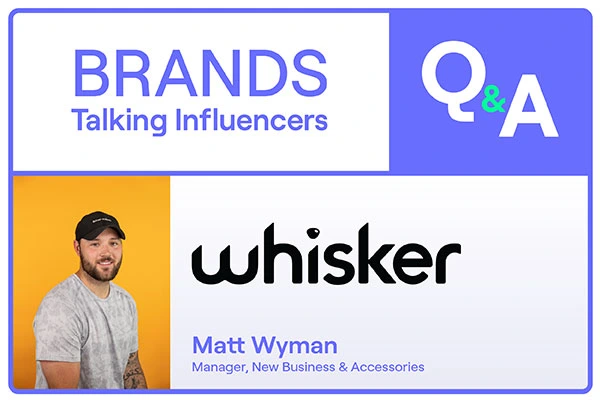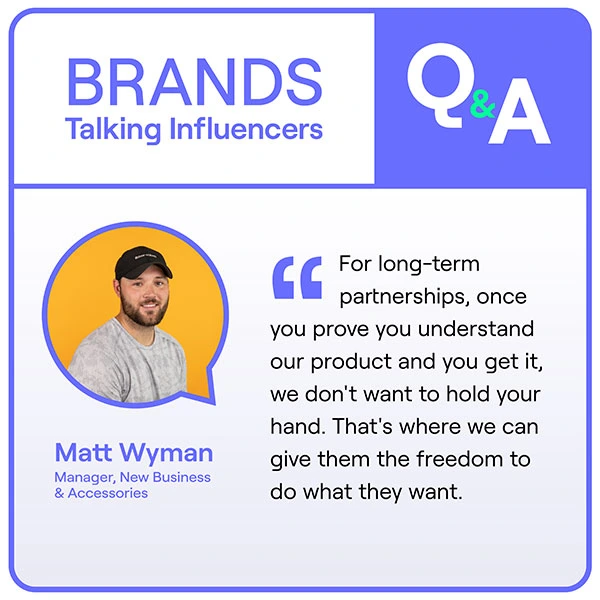

Director of Marketing
Content at GRIN
Welcome to the GRIN gets real podcast, the show for people who want to maximize their marketing potential. From influencer marketing to eCommerce strategy and everything in between, each episode will feature industry experts that share their insights and provide actionable tips to help you achieve your marketing goals. Subscribe and stay tuned!

[audio src="https://grin.co/wp-content/uploads/2022/06/BTIxGGR_Podcast_QA-Whisker_2022_Q2_05-1.mp3" /]
Whisker Manager of New Business & Accessories
Whisker works tirelessly to solve problems and deliver smarter insights for pet parents while enriching the lives of pets. As the leading innovator in pet tech and refined pet accessories, Whisker leverages influencers to help deliver better solutions for its customers while transforming the pet care industry along the way.
“With us having a $650 product, it’s not something where we can have an influencer post and see a ton of conversions. Conversions are added bonuses for us. So we want to get people learning about it, get their information, and then retarget them with ads that will ultimately make them convert.”Whisker has the most success partnering with brand-aligned influencers with a high engagement rate and strong connection with their followers. Those creators help spread awareness for Whisker and its products and generate a list of prospects the brand can later retarget with ads. While sales are a bonus, Whisker’s influencer marketing program is all about building trust and brand love. In this episode, you will learn:

Katya: All right, Matthew, thank you so much. Welcome to the GRIN Gets Real podcast. Thank you for coming back with me on the podcast. We just finished wrapping up our fireside chat, and we’ve got some unanswered questions to go through. Are you ready?
Matthew: Ready as I’ll ever be.
Katya: I like that. All right. Here’s our first question: Are influencers working better than ads for you? Or would you say the ads have an overall better conversion?
Matthew: Ads will have a better conversion with the caveat that our influencer marketing is not super conversion-driven. With us having a $650 product, it’s not something where we can have an influencer post and see a ton of conversions. Conversions are added bonuses for us. So we want to get people learning about it, get their information, and then retarget them with ads that will ultimately make them convert.
Katya: And I would also say, if you have a high-ticket item it generally just takes someone longer to purchase. It’s not an impulse purchase. And because of that, it’s a longer journey for someone.
Matthew: Yeah, we need to move them through the marketing funnel. That’s where we start.
Katya: Do you assign a ton of value to getting the email from a potential customer because it is a longer customer journey?
Matthew: Yeah. Giveaways is a big thing we do. Like our 12 Days of Christmas; that generates hundreds of thousands of emails for us, and we use influencers to promote that. Get them to the page, get their information, and that gives us everything we need for our performance team to then market them through email, market them on social ads, etc.
Katya: Love that. That wasn’t a question from here. That was just a “me” question. What do you look for when choosing an influencer? How do you determine if someone is a good brand fit?
Matthew: Well, they need to have a cat first. So that’s our No. 1 thing. But it really depends on what we are trying to get out of them. What is their bread and butter? Are they a YouTube creator that has a vlog-style channel?
It’s also nice when an influencer expresses their passion, which can be hard with larger influencers when you don’t have direct communication to them. So assigning value is difficult as is. And that’s something where Cheyenne and I meet, pull a report, talk through what we want to get out of them, set a goal in terms of CPM on what we think is fair, and then we make an offer. And if the influencer doesn’t align with that value, sure, we can go up a little and negotiate, but we tend to stand pretty firm on what we value the partnership at because, ultimately, it’s got to be mutually beneficial. And sometimes, creators can ask for numbers that make it impossible to ever justify it.
Katya: That makes sense. Does Whisker have a web3 influencer strategy?
Matthew: No. Short and sweet.
Katya: How do you attribute brand awareness/engagement driven by influencer content to revenue? Do you need those things to drive revenue?
Matthew: Yes and no. It’s hard to tie directly to revenue when we’re focusing on an awareness campaign. But we know if we launch an influencer campaign, we feel those spikes. We see the benefit of influencer marketing after that campaign is done. And after retargeting people, we can see the movement in our graphs.
Katya: Are you looking at Google Analytics? Are you looking at just the revenue numbers? So like, do you see those spikes in website traffic and sales coming in?
Matthew: Yes, yeah.
Katya: Oh, nice. Would you say for TikTok, you are investing in 500k to 1 million followers for your paid partnerships or focusing on volume with more micro-mid creators? Where have you seen the most return?
Matthew: We would rather work with somebody that has a 10% engagement rate than someone with 50 million followers that has half a percent engagement rate. They both have their pros and cons. But we would push to that person that’s engaging with their followers, and their followers really care about everything that they’re posting.
But in terms of followers, it varies. I would say we’re more in the 100,000 to 500,000 range. But for this awareness campaign, we did focus on some larger hero creators. And for this specifically, we had a good combination of all.
Katya: Do you approve creator content first?
Matthew: Most of the time.
Katya: OK. Are they sending that to you via email? Are they uploading it within the live URL in GRIN? How are you guys doing that?
Matthew: Sometimes they can import their content through GRIN, or they can send it through email. Sometimes we will use spreadsheets where we can manage just the content idea; then, they can upload their content for us to approve.
But for long-term partnerships, once you prove you understand our product and you get it, we don’t want to hold your hand. That’s where we can give them the freedom to do what they want. And, like, an idea that we’re working on right now is more of a “creator house” where we bring on 10-15 influencers that we work with for X number of months. They give us posts that we can populate our TikTok channel with to start growing that organically and not focusing on them posting themselves but giving us unique content that we can post.
Katya: I love that. Do you pay influencers, or is it profit share?
Matthew: No. I guess you could call our affiliate program a profit share, but we try to use it as a, “Hey, can we get you in at a lower cost?” And I get why they don’t want to do it. They want to have the upfront cost—they want to make sure they get their money right away. I think for smaller influencers, it’s easier to say, “Hey, we’re gonna send you the product. We’re not open to paying you, but you’re going to earn 8% commission on every sale that you generate through your link.” And that makes them want to work harder, and we don’t have to put that upfront cost.
Katya: Perfect answer. How long do you negotiate usage for? Is it in perpetuity? Is it limited to just social or website, email, newsletter, etc.?
Matthew: It’s all dependent on who the creator is. Some people hold on to their content. It could be somebody that doesn’t have a ton of followers, but maybe they’re an artist, and we’re working with them on an animation where they don’t want to give that up. They’re gonna work hard. It’s in their portfolio, where we would work out a different usage than somebody with 10,000 followers where we worked out, “Hey, we want to send you a unit you need to post, and we want 25 images that we own exclusively.” It’s all creator-dependent.
Katya: What platform did you use for your live campaign?
Matthew: So the platform is called Restream. And that was something that a colleague handled. We had a few other people there, too. There was a lot that went into it to set up a professional-looking live event. And we even had a host who’s an Emmy-winning news anchor out in Las Vegas. So that was somebody that we brought on, knowing that we needed somebody that could command attention and know how to go from one thing to the next.
So yeah, we use Restream, and we can connect that to a bunch of different platforms. And it allows the creators to go live with it. We did two tests on Restream before, and then we did our big Whisker Live. So the idea came together pretty quickly, and we moved pretty fast on it.
Katya: So, those influencers were also streaming live from their channels?
Matthew: They can. We didn’t request it, but that is an option on there. And something we would do in the future. That’s a good idea.
Katya: I mean, that maximizes the exposure of what you’re doing from a brand perspective. How do you deem a paid post successful? What ROI or number of impressions do you look for?
Matthew: We have a metric calculator that we’ll use. So before we enter into an agreement, we’ll run that, and that’s really how we define success in terms of engagement or impressions. And the nice thing about GRIN is that you guys have a paid performance or a paid post-performance tool that can show us the difference. So we can manage expectations. And we know that if a creator has a 7% engagement rate on non-paid posts, it’s not going to be as high for paid posts. We use that tool a ton to really help us define success.
But then we use a lot of influencers for just content needs. Maybe we need a pregnant mom with a white cat. We can go on Instagram, and we can search around, and we can find somebody that’s pregnant and has a white cat. We can work out something cheaper with them or get images that we need for emails and website content.
Katya: That’s oddly specific. But I’m gonna trust there is a reason for it.
Matthew: Toxoplasmosis. You’re not supposed to scoop cat litter.
Katya: Yeah, that makes sense. You can tell I’m not a cat owner. But hey, if you guys come up with a dog one, I’ll pay thousands of dollars for it.
But anyway, how many launches or campaigns do you have a year? Or per quarter?
Matthew: So campaigns, we would tie it to marketing initiatives. We run like a “Scoopless Summer” giveaway where we’ll tie influencers into a summer giveaway, where we’re giving away little robots for, I think, 2 or 3 months. So one a week for the entire summer.
We also have our holiday campaign. This year, we did a “New Year, No Smell” campaign for an odor trap product that we had.
And then we do ongoing campaigns every month where some months we’ll have five influencers, then the next month we might have 35 influencers. And that’s where we will tie it to the time of year. So Pride is coming up, which is a big one. We’ll do a little Pride campaign where we’ll work with an artist who’s going to draw something Pride-related or reconnect with that community that it’s important to. But in terms of campaigns, that really depends. If something pops up, we’ll start a campaign about it.
Katya: Do you have an evergreen campaign where you’re continuing to look for new influencers to put into your program?
Matthew: Yeah, that is outside of our campaigns. That’s every month, and it’s just kind of lining up influencers for each month or in advance. It’s not tied to a specific campaign. It’s a one-off partnership with a particular creator.
Katya: What happens when you pay for a supposed influencer, and you find that all the traffic was from bots that didn’t generate any sales?
Matthew: That was our problem before GRIN. We don’t have that problem anymore. When we can use a tool that tells you a credibility score, and that score is below a certain number, we’re not interested, and it doesn’t matter what you do. You could say we’re gonna give you 100 videos for the next 100 years, and we still wouldn’t do it. So GRIN has been our solution to make sure that we’re vetting influencers and not working with people that are ruining the influencer space.
Katya: I love it. It also sounds like you guys take advantage of the Audience Insights report.
Matthew: Yeah, I think yesterday we declined an influencer just based on their audience demographics. And that’s something that we would never know without GRIN. So if you have 25% of your followers in the U.S., it doesn’t add a ton of value to us, because we’re focused on growing our U.S. market.
Katya: Where have you seen the most return in the last quarter? TikTok or IG, and was this with macro or micro partnerships?
Matthew: We have been super focused on TikTok, and we think TikTok is going to be a better performer than Instagram. TikTok is the hot platform right now, and that’s been our focus. That’s where we’ve put all of our eggs.
Katya: I think so many brands are trying to really dive into TikTok and figure it out. I mean, it’s not a new platform, but I feel like it’s new when it comes to influencer marketing. My advice would always just be to do a ton of testing. It’s going to be a different product for every brand and every sponsor.
Matthew: Yeah, something that works for us might not work for a swimsuit company.
Katya: Yeah. Wild comparison. Now, do you use discount codes with your affiliates?
Matthew: Yep, we do. And we do have a professional pricing program for people that deal with cats every day. So, vets, shelters, and things, they can get a discount on our products. But for the general public, we do a $25 off affiliate offer. And that is what our affiliates can offer. That’s it. We break it out into an affiliate program and a refer-a-friend program. And that was more for complexity. And then we changed affiliate platforms, and we found that you really had to be a true affiliate marketer to understand and be successful. Otherwise, it was just question after question after question. So we started our refer-a-friend program where you could sign up and offer $25 off to somebody, and you would earn $25 to our site where a traditional affiliate can earn a commission and offer that $25 off. So my long answer: Yes, we do $25 discounts.
Katya: I appreciate the long answer because that leads me to another question. Do you think it’s more valuable for a brand to include a good creator mix that has affiliates?
Matthew: I think they are both super important. I think companies should invest in both of them. They’re very different. Our affiliate program is more under our performance team and finding big publishers that we can bring on as affiliates that can really move the needle, whereas influencers are much different. They’re not bloggers. Not that we separate the two, but they are both super important. And there is a little bit of crossover where a certain influencer might also be a great affiliate.
Katya: What does a “one-time gifting” contract or negotiation look like if you want to continue to get ROI?
Matthew: We always try to kick off a partnership as cheaply as possible. I let them know what we need initially and check how they perform to determine if they are going to be a good long-term fit. Once they prove that, we usually send trackable links so we can monitor things and see exactly what’s going on. And if you have awesome content, you’re getting clicks, and your engagement is awesome, we will then pump money into more posts from you.
So measuring ROI is a little bit difficult when we’re not talking about performance marketing. That’s not our program right now. We’re not focused on an immediate return on investment. We want people talking about our product. And until we have enough people talking about our product, that’s when we can then go and focus more on an ROI campaign.
Katya: Yeah, you bring up a really good point because it is really hard when it is not performance coming from the performance team, which we call our growth team. Because I think when you are looking at ROI, so many people look at the bottom line sales. And yes, that is a very direct return on investment. But I think being able to stretch it out to that continued education adds to that return on investment.
Matthew: If brand awareness is what we are trying to get out of it, then yes. We measure it differently when we are talking about dollars. If we measured success in dollars, we would look at influencer marketing and say, “Yeah, maybe we shouldn’t do this.” But that’s not what we are trying to get out of it.
Katya: Are you finding these non-pet influencers through GRIN?
Matthew: Some of them. We also kind of just find them searching around. We also get a ton of cool people who want to reach out to us for partnerships. So we use GRIN, but we also go through and do just manual hashtag searches. We use a bunch of different methods of finding influencers—GRIN being one of them.
Katya: What is a fair or average CPM for consumer goods? How do you best identify or target your CPM?
Matthew: We break it out by platform. YouTube has a much higher CPM. So that can be anywhere from $15 to $45, depending on who the creator is. For Instagram or TikTok, we would aim for more of a $5 to $10 CPM. I mean, YouTube is the long-form video that people are watching. Plus, you’re getting people that are searching for specific videos or searching for creators that they like to watch. Then on TikTok, a view can count in one second as soon as somebody plays it. So yeah, much lower CPM for Instagram and Tik Tok compared to YouTube.
There are a few different factors to identify or target our CPM. For example, who’s the influencer? How big are they? What’s their following? What’s their engagement rate? We take all this into consideration, and then we have a calculator that we put it into.
For example, let’s say it’s a $10 CPM. I’ll plug in $30,000. Then for $30,000, we’ve got to get X number of views for us to feel good about this partnership. If they’re a huge influencer, they’ve got a powerful name, and they’ve amassed a huge following, we will take that into consideration. There’s no perfect answer. We just plug in numbers, and I’ll use my gut for what feels right and what feels wrong.
Katya: Yeah, I think it’s experience, right? You’ve had enough experiences with the different types of influencers across different types of platforms to really be willing to take a chance. And then you go into it with your eyes wide open.
What size of influencer do you typically work with when just gifting or using an affiliate?
Matthew: Size does not matter. It just depends on the influencer. Some people want it really badly. And they’re open to getting the product. And they want to promote because they want the product. There’s other people that might have a really small following, but they think highly of their content and themselves and the small following that they’ve built where they don’t want to work for a free product. We’ve had people with 10,000 followers where we can gift it to them. And we’ve had people with hundreds of 1,000s of followers that are just open to posting about it because it’s cool.
Katya: What type of budget do you work with influencers?
So for 2022, we’ll definitely be around seven figures. I’d say several hundred thousand, depending on the month. But yeah, yearly spend will likely be seven figures.
Katya: Nice. Now, you sort of answered this one, but I have a follow-up. Do you use discount codes and/or affiliate links? And when I’m asking that, I’m not talking about commissions. I’m not talking about affiliate links that have commissions tied to it. Do you leverage affiliate links for tracking purposes?
Matthew: Yes. And I think maybe it feels more like more of an influencer link. Like, an affiliate link I would tie to commission, and an influencer link I would tie to a specific web page that we can track that has no commission or offer tied to it.
Katya: OK, perfect. And here’s the final question. Do you have an “always-on” campaign with influencers? Or do you just use them when you need them?
Matthew: We’re always working with influencers. I won’t call it an ongoing campaign, but we’re lining up one-off partnerships every month. We may have a specific campaign going on at that month, but for each month, we always have influencers that are going to be activated on one-off partnerships that eventually turn into something larger.
Katya: Nice. Well, thank you so much, Matthew. I know that we lost the video towards the end, but you have dropped a ton of knowledge. Thank you for letting me steal so much of your time, and I hope that we can continue to ask you questions after.
Matthew: Absolutely. I had a blast. Thanks for having me on. And for anyone out there looking into GRIN, it’s an awesome platform, and I definitely recommend it. Thanks for having me.


Director of Marketing
Content at GRIN
Welcome to the GRIN gets real podcast, the show for people who want to maximize their marketing potential. From influencer marketing to eCommerce strategy and everything in between, each episode will feature industry experts that share their insights and provide actionable tips to help you achieve your marketing goals. Subscribe and stay tuned!